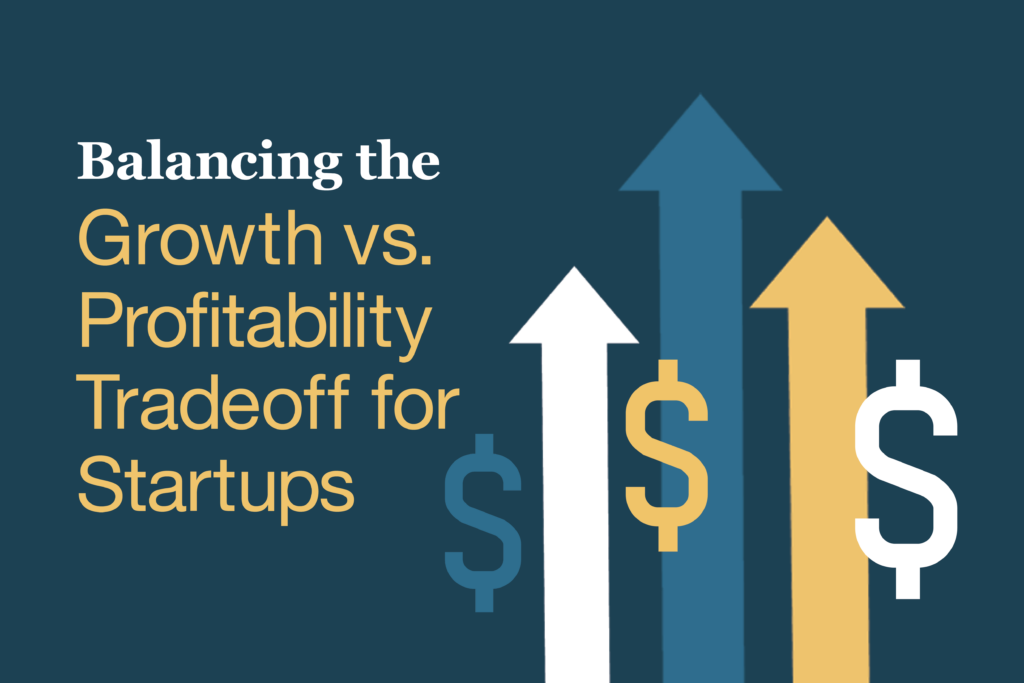Balancing the growth vs. profitability tradeoff—how do you do it? It’s the age-old question in the startup world.
Of course, both growth and profitability are important. But when it comes to the reality of startup life, you may have to lean heavily towards one or the other.
That’s why we met with fractional CFO Anthony Rosen, who has decades of experience in consumer goods financial expertise. We wanted to see what he thinks about balancing the growth vs. profitability tradeoff for startups.
Understanding the Growth vs. Profitability Tradeoff
According to Anthony, the first thing to consider when balancing growth and profitability is the startup’s size and valuation.
As a general rule, smaller startups need to think about profitability sooner because they have to be practical—a small investment round rarely lasts long. But with a $50 million runway, you have the luxury of focusing on growth if you want to. Even if your operating expenses are 50 times higher than that of a startup that only raises $1 million, it’s easier to be creative.
It’s also important to consider trajectory. Is your goal to be worth $10 million or $10 billion in 10 years? Your total addressable market (TAM) and the strength of your competition must also be considered. If your company has to grow quickly to be competitive, then growth should be the priority.
Fundraising is also crucial for balancing growth and profitability. If you want to focus on growth, you’ll need investors who have their own goals. Even if they seem to be 100% aligned, expect to sacrifice more equity than you’d like to get them on board. Meanwhile, bootstrapping means you get to retain control of your company, but can also lead to significantly slower growth.
Understanding The State of the Market
Investor and founder goals can change every year, sometimes much more than anyone might expect.
A great example of this was the seismic shift in investor appetites between 2021 and 2023. When interest rates were low, venture capital flowed easily. But just a few years later, the Federal Reserve’s rate-hiking campaign began and investor funds dried up for a while.
Put another way, “Back in the day, growth was all that mattered. But now, profitability is extremely important,” says Anthony. The days of easy-money unicorns like WeWork and Uber are likely over, at least for the time being. Sky-high interest rates and global macro headwinds are not doing startup founders any favors.
These challenging fundraising conditions have forced many startups to bootstrap operations. Most investors are playing the waiting game or are only interested in opportunistic valuations. “In today’s market, you have to assume that you can’t raise money again,” Anthony explained. “Not every founder is going to listen to this advice, but…you have to assume the worst-case scenario.”
By the way, this is true of both equity and debt investments. In a high interest rate environment, lenders aren’t necessarily jumping at every opportunity to originate loans, either. High interest rates make refinancing a whole lot harder, and more loans are likely to default.
In other words, if you want to emerge victorious in today’s startup market, you have to already be profitable, or at least have a very clear path to profitability.
A Growth vs. Profitability Case Study
Anthony shared a recent case study that shows how balancing the growth vs. profitability tradeoff works in the real world.
One founder has been running a consumer goods business for the past five years. She’s raised $3 million and grown the business to a revenue of approximately $15 million. With that kind of success, should she just enjoy her hard-earned money, or focus on growing the business even more?
The answer is not so cut and dry. Some investors are pushing her to achieve a 10% EBITDA margin, but that shouldn’t necessarily be her top priority. This founder doesn’t want to raise more capital and is very cash-focused.
Anthony advised her to frame her path forward around her exit strategy. If you’re trying to exit immediately, profitability is more important. For our founder, the right move was to focus on growth while not overlooking profitability altogether. She ended up setting her sights on a 5% EBITDA margin while staying flexible enough to pivot as needed.
Considering Both Profitability and Growth
A sound financial model should consider both profitability and growth, with the understanding that things are always changing. Plan B often becomes Plan C, which soon turns into Plan D.
For instance, you can showcase your financial projections over the next five years. By then, your company will be net cash flow positive, interest rates will have calmed down, and investors should be willing to invest at more favorable terms.
But the reality is there’s no way to know if any of that will happen.
That’s why Anthony advises startups to “Focus on survival, especially in the beginning.” You can’t run your business today by assuming what 2028 could look like. “You have to do what your business needs to do to survive—what’s working is what matters.”

Working With The Right Financial Partner
How you prioritize growth vs. profitability will likely change several times over the years. Your job as a startup founder is to evolve and adapt quickly.
And that’s why having a knowledgeable CFO can be such a game-changer. The right financial partner for your startup should be more than just a fiduciary, they should also think like a founder and business owner in order to give you the actionable insights that matter most.



